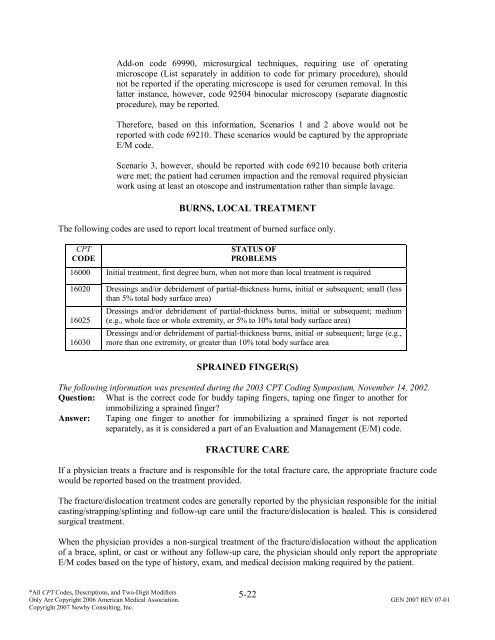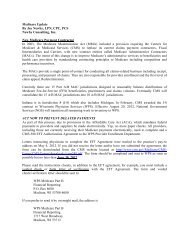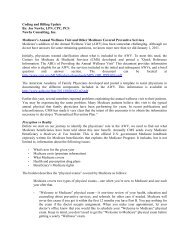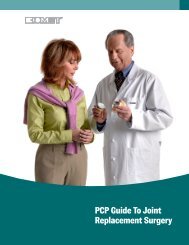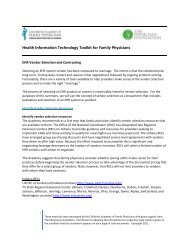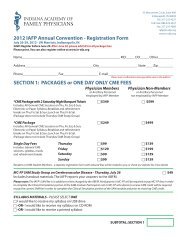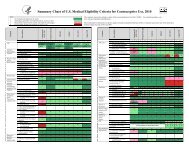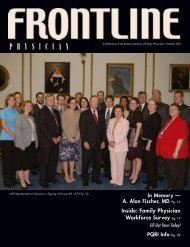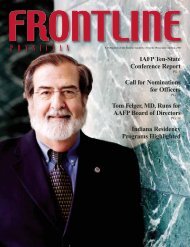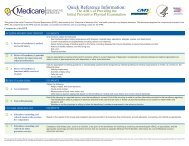pqri measure coding and reporting principles - Indiana Academy of ...
pqri measure coding and reporting principles - Indiana Academy of ...
pqri measure coding and reporting principles - Indiana Academy of ...
You also want an ePaper? Increase the reach of your titles
YUMPU automatically turns print PDFs into web optimized ePapers that Google loves.
Add-on code 69990, microsurgical techniques, requiring use <strong>of</strong> operating<br />
microscope (List separately in addition to code for primary procedure), should<br />
not be reported if the operating microscope is used for cerumen removal. In this<br />
latter instance, however, code 92504 binocular microscopy (separate diagnostic<br />
procedure), may be reported.<br />
Therefore, based on this information, Scenarios 1 <strong>and</strong> 2 above would not be<br />
reported with code 69210. These scenarios would be captured by the appropriate<br />
E/M code.<br />
Scenario 3, however, should be reported with code 69210 because both criteria<br />
were met; the patient had cerumen impaction <strong>and</strong> the removal required physician<br />
work using at least an otoscope <strong>and</strong> instrumentation rather than simple lavage.<br />
BURNS, LOCAL TREATMENT<br />
The following codes are used to report local treatment <strong>of</strong> burned surface only.<br />
CPT<br />
CODE<br />
STATUS OF<br />
PROBLEMS<br />
16000 Initial treatment, first degree burn, when not more than local treatment is required<br />
16020 Dressings <strong>and</strong>/or debridement <strong>of</strong> partial-thickness burns, initial or subsequent; small (less<br />
than 5% total body surface area)<br />
16025<br />
16030<br />
Dressings <strong>and</strong>/or debridement <strong>of</strong> partial-thickness burns, initial or subsequent; medium<br />
(e.g., whole face or whole extremity, or 5% to 10% total body surface area)<br />
Dressings <strong>and</strong>/or debridement <strong>of</strong> partial-thickness burns, initial or subsequent; large (e.g.,<br />
more than one extremity, or greater than 10% total body surface area<br />
SPRAINED FINGER(S)<br />
The following information was presented during the 2003 CPT Coding Symposium, November 14, 2002.<br />
Question: What is the correct code for buddy taping fingers, taping one finger to another for<br />
immobilizing a sprained finger<br />
Answer: Taping one finger to another for immobilizing a sprained finger is not reported<br />
separately, as it is considered a part <strong>of</strong> an Evaluation <strong>and</strong> Management (E/M) code.<br />
FRACTURE CARE<br />
If a physician treats a fracture <strong>and</strong> is responsible for the total fracture care, the appropriate fracture code<br />
would be reported based on the treatment provided.<br />
The fracture/dislocation treatment codes are generally reported by the physician responsible for the initial<br />
casting/strapping/splinting <strong>and</strong> follow-up care until the fracture/dislocation is healed. This is considered<br />
surgical treatment.<br />
When the physician provides a non-surgical treatment <strong>of</strong> the fracture/dislocation without the application<br />
<strong>of</strong> a brace, splint, or cast or without any follow-up care, the physician should only report the appropriate<br />
E/M codes based on the type <strong>of</strong> history, exam, <strong>and</strong> medical decision making required by the patient.<br />
5-22<br />
*All CPT Codes, Descriptions, <strong>and</strong> Two-Digit Modifiers<br />
Only Are Copyright 2006 American Medical Association. GEN 2007 REV 07-01<br />
Copyright 2007 Newby Consulting, Inc.


